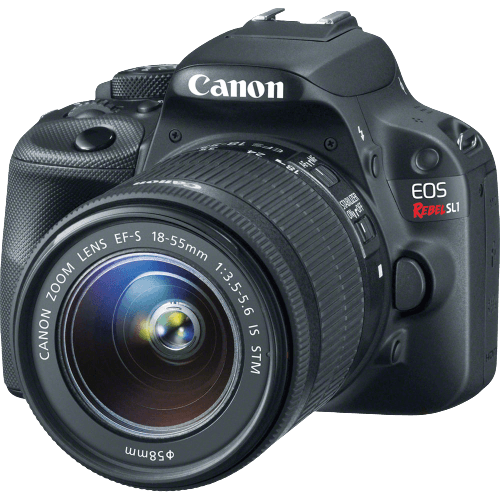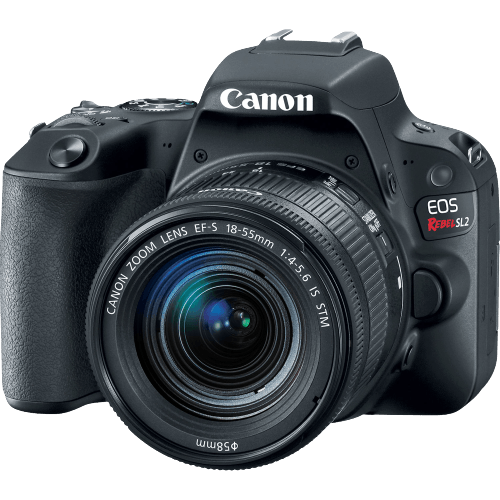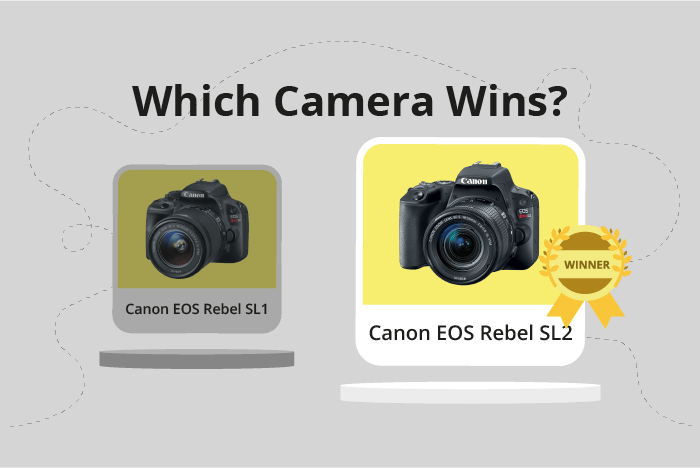Canon EOS Rebel SL1 / 100D vs EOS Rebel SL2 / 200D Comparison
Canon EOS Rebel SL1 / 100D

Canon EOS Rebel SL2 / 200D

The Canon EOS Rebel SL2 / 200D outperforms the Canon EOS Rebel SL1 / 100D, scoring 62/100 compared to the SL1’s 43/100. Both cameras are DSLR models, announced in 2017 and 2013 respectively, and share similar dimensions. However, the SL2 is significantly lighter at 302g compared to the SL1’s 407g, making it more convenient for travel.
The SL2 also boasts a lower launch price of $550, compared to the SL1’s $650, offering better value for money. The SL1, on the other hand, has no clear advantages over the SL2. Therefore, the Canon EOS Rebel SL2 / 200D emerges as the superior choice for consumers seeking a lightweight, affordable DSLR camera.
Canon EOS Rebel SL1 / 100D vs EOS Rebel SL2 / 200D Overview and Optics
The Canon EOS Rebel SL2 / 200D emerges as the winner in the optics comparison, scoring 62 points, while the Canon EOS Rebel SL1 / 100D scores 40 points. Both cameras share some common specifications, such as the CMOS sensor type, APS-C sensor size, Canon EF-S lens mount, and the absence of image stabilization.
The SL2 / 200D outperforms the SL1 / 100D in several aspects. With 24.2 megapixels, it captures more detailed images compared to the SL1 / 100D’s 18 megapixels. The SL2 / 200D also has a faster shooting speed of 5 frames per second, enabling users to capture fast-moving subjects more efficiently than the SL1 / 100D’s 4 frames per second. Moreover, the SL2 / 200D features a more advanced Digic 7 processor, which contributes to better image quality and faster processing. Lastly, the SL2 / 200D has a higher DXOMARK score of 79 for its sensor, indicating improved performance in low light and dynamic range compared to the SL1 / 100D’s score of 63.
The SL1 / 100D does not have any notable advantages over the SL2 / 200D in terms of optics. Both cameras share similar limitations, such as the lack of image stabilization.
Taking all these factors into account, the Canon EOS Rebel SL2 / 200D is the superior choice when it comes to optics. With its higher megapixel count, faster shooting speed, more advanced processor, and better sensor performance, it is better equipped to capture high-quality images in various shooting situations. The Canon EOS Rebel SL1 / 100D, on the other hand, falls short in these aspects, making it less suitable for users seeking optimal image quality and performance.
Canon EOS Rebel SL1 / 100D vs EOS Rebel SL2 / 200D Video Performance
The Canon EOS Rebel SL2 / 200D emerges as the winner in video capabilities with a score of 70/100, outperforming the Canon EOS Rebel SL1 / 100D, which scored 43/100. Both cameras share certain specifications, such as maximum video resolution of Full HD and maximum video dimensions of 1920 x 1080. However, there are specific features that set them apart and contribute to their respective scores.
The Canon EOS Rebel SL2 / 200D boasts a higher maximum video frame rate of 60fps, whereas the Canon EOS Rebel SL1 / 100D’s maximum video frame rate is 30fps. This difference allows the SL2 / 200D to produce smoother and more detailed videos, which is particularly beneficial for capturing fast-moving subjects or creating slow-motion effects. Furthermore, the SL2 / 200D includes built-in time-lapse functionality, enabling users to create stunning time-lapse videos without requiring additional software or equipment.
On the other hand, the Canon EOS Rebel SL1 / 100D does not offer any specific advantages over the Canon EOS Rebel SL2 / 200D in terms of video capabilities. Its lower score results from the lack of advanced features such as a higher frame rate and built-in time-lapse functionality.
Considering the aforementioned points, the Canon EOS Rebel SL2 / 200D is the superior choice for those seeking enhanced video capabilities. Its higher frame rate and built-in time-lapse functionality provide users with more creative options and better video quality. In contrast, the Canon EOS Rebel SL1 / 100D falls short in this area and may not be the ideal choice for videographers or those who prioritize video performance in their camera selection.
Canon EOS Rebel SL1 / 100D vs EOS Rebel SL2 / 200D Features and Benefits
The Canon EOS Rebel SL2 / 200D wins in the feature comparison with a score of 70/100, while the Canon EOS Rebel SL1 / 100D scores 57/100. Both cameras share some specifications, such as a 3-inch screen size, screen resolution of 1,040,000 dots, and a touchscreen. Neither camera has GPS functionality.
The SL2 / 200D outperforms the SL1 / 100D in several areas. It has a flip screen, which allows for more versatile shooting angles and easier self-portraits. The SL2 / 200D also includes Wi-Fi and Bluetooth capabilities, enabling seamless photo sharing, remote control, and connection to additional devices. These features make the SL2 / 200D more user-friendly and adaptable to various shooting situations.
On the other hand, the SL1 / 100D does not offer any significant advantages over the SL2 / 200D. It lacks a flip screen, Wi-Fi, and Bluetooth, making it less versatile and convenient for users. The absence of these features gives the SL2 / 200D a clear edge in the feature comparison.
To conclude, the Canon EOS Rebel SL2 / 200D is the superior camera in terms of features, with its flip screen, Wi-Fi, and Bluetooth capabilities. The Canon EOS Rebel SL1 / 100D falls short in these areas, making it a less attractive option for photographers seeking versatility and convenience. The SL2 / 200D’s higher score reflects its better performance and enhanced user experience.
Canon EOS Rebel SL1 / 100D vs EOS Rebel SL2 / 200D Storage and Battery
The Canon EOS Rebel SL2 / 200D stands out as the winner in storage and battery, with a score of 32/100, while the Canon EOS Rebel SL1 / 100D scores 21/100. Both cameras share similarities, such as having one memory card slot and supporting SD, SDHC, and SDXC memory cards. However, the SL2 / 200D is UHS-I compatible, providing faster read and write speeds.
The SL2 / 200D’s advantage lies in its superior battery life, offering 650 shots compared to the SL1 / 100D’s 380 shots. Additionally, the SL2 / 200D uses the LP-E17 battery type, while the SL1 / 100D uses the LP-E12. Neither camera supports USB charging.
Though the SL1 / 100D falls short in this comparison, it still offers decent storage options and a satisfactory battery life for casual users. Ultimately, the SL2 / 200D is the better choice for those prioritizing extended battery life and faster memory card compatibility.
Canon EOS Rebel SL1 / 100D vs EOS Rebel SL2 / 200D – Our Verdict
Are you still undecided about which camera is right for you? Have a look at these popular comparisons that feature the Canon EOS Rebel SL1 / 100D or the Canon EOS Rebel SL2 / 200D:

